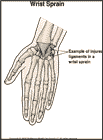
Wrist Sprain
What is a wrist sprain?
A sprain is an injury to a joint that causes a stretch or tear in a ligament. Ligaments are strong bands of tissue that connect one bone to another. Your wrist is made up of eight bones that are attached to your hand bones and the bones of your forearm. The wrist joint is covered by a joint capsule and the bones are connected by ligaments.
How does it occur?
A wrist sprain can happen when you fall on your wrist or hand, when you are struck by an object, or during a forced motion of the wrist.
What are the symptoms?
You have pain, swelling, and tenderness in your wrist.
How is it diagnosed?
Your health care provider will review your symptoms and examine your wrist. He or she may order an x-ray to be sure you have not broken any bones in your wrist.
How is it treated?
Treatment may include:
- putting ice packs on your wrist for 20 to 30 minutes every 3 to 4 hours for 2 or 3 days or until the pain goes away
- elevating your wrist on the back of a chair or couch when you are sitting or on a pillow when you are lying down (to help reduce swelling)
- taking an anti-inflammatory or other pain medication prescribed by your health care provider
- wearing a splint or cast on your wrist to prevent further injury
- doing exercises to help your wrist recover.
While you are recovering from your injury you will need to change your sport or activity to one that does not make your condition worse. For example, you may need to run instead of playing basketball.
When can I return to my sport or activity?
The goal of rehabilitation is to return you to your sport or activity as soon as is safely possible. If you return too soon you may worsen your injury, which could lead to permanent damage. Everyone recovers from injury at a different rate. Return to your sport or activity will be determined by how soon your wrist recovers, not by how many days or weeks it has been since your injury occurred. In general, the longer you have symptoms before you start treatment, the longer it will take to get better.
You may return to your sport or activity when the injured wrist can move normally without pain. Your health care provider may allow you to return to competition with your wrist taped or in a brace. Your injured wrist, hand, and forearm need to have the same strength as the uninjured side. You must not have any pain when doing activities such as swinging a bat or a racquet or performing tumbling in gymnastics.
How long will the effects last?
How long it takes your wrist to heal depends on:
- your age
- your health
- how severe your injury is
- whether your wrist has been injured before.
How can I prevent a wrist sprain?
A wrist sprain usually occurs during an accident that is not preventable. However, when you are doing activities such as rollerblading be sure to wear protective wrist guards.

